Sustainable Tourism Development Planning in the Philippines
VerifiedAdded on 2020/01/16
|28
|6808
|254
Report
AI Summary
This report delves into the sustainable tourism development within the Philippines, examining the rationale for planning in the tourism industry and analyzing various approaches to tourism development planning at different levels. It highlights the benefits stakeholders, including tourists, local residents, private businesses, and the government, derive from tourism planning, and discusses the advantages and disadvantages of public-private sector partnerships. The report evaluates the importance of interactive planning systems and methods to measure the impact on tourists. It also addresses the integration of sustainability in tourism development, factors preventing such development, and stages in planning for sustainability. Furthermore, the report evaluates methods to resolve conflicts of interest, the implications of balancing supply and demand, and the moral and ethical issues of enclave tourism. Finally, it compares current issues related to tourism development in developing countries and provides recommendations for the future development of tourism in the Philippines. This comprehensive analysis offers insights into the complexities and opportunities within the Philippines' tourism sector.
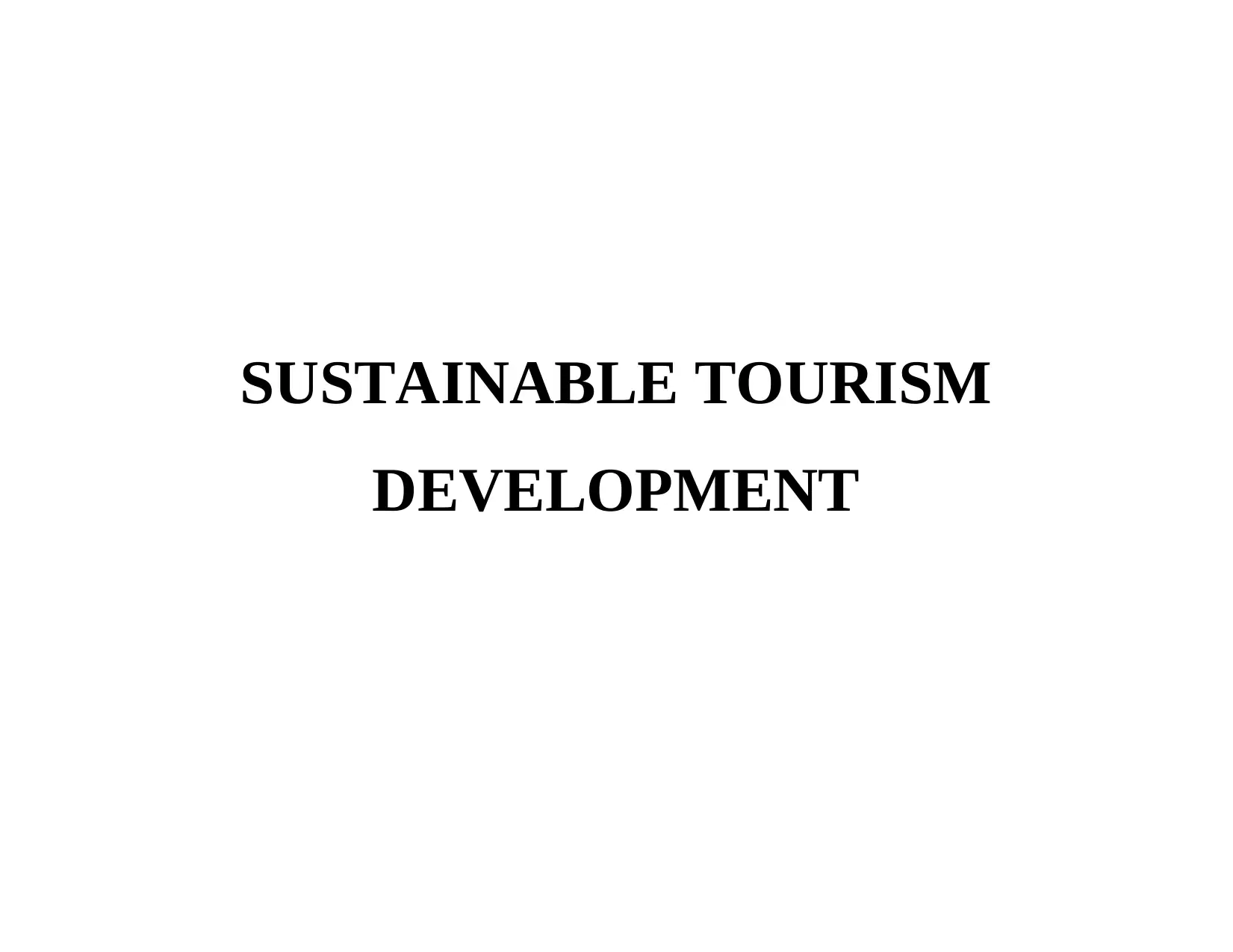
SUSTAINABLE TOURISM
DEVELOPMENT
DEVELOPMENT
Paraphrase This Document
Need a fresh take? Get an instant paraphrase of this document with our AI Paraphraser
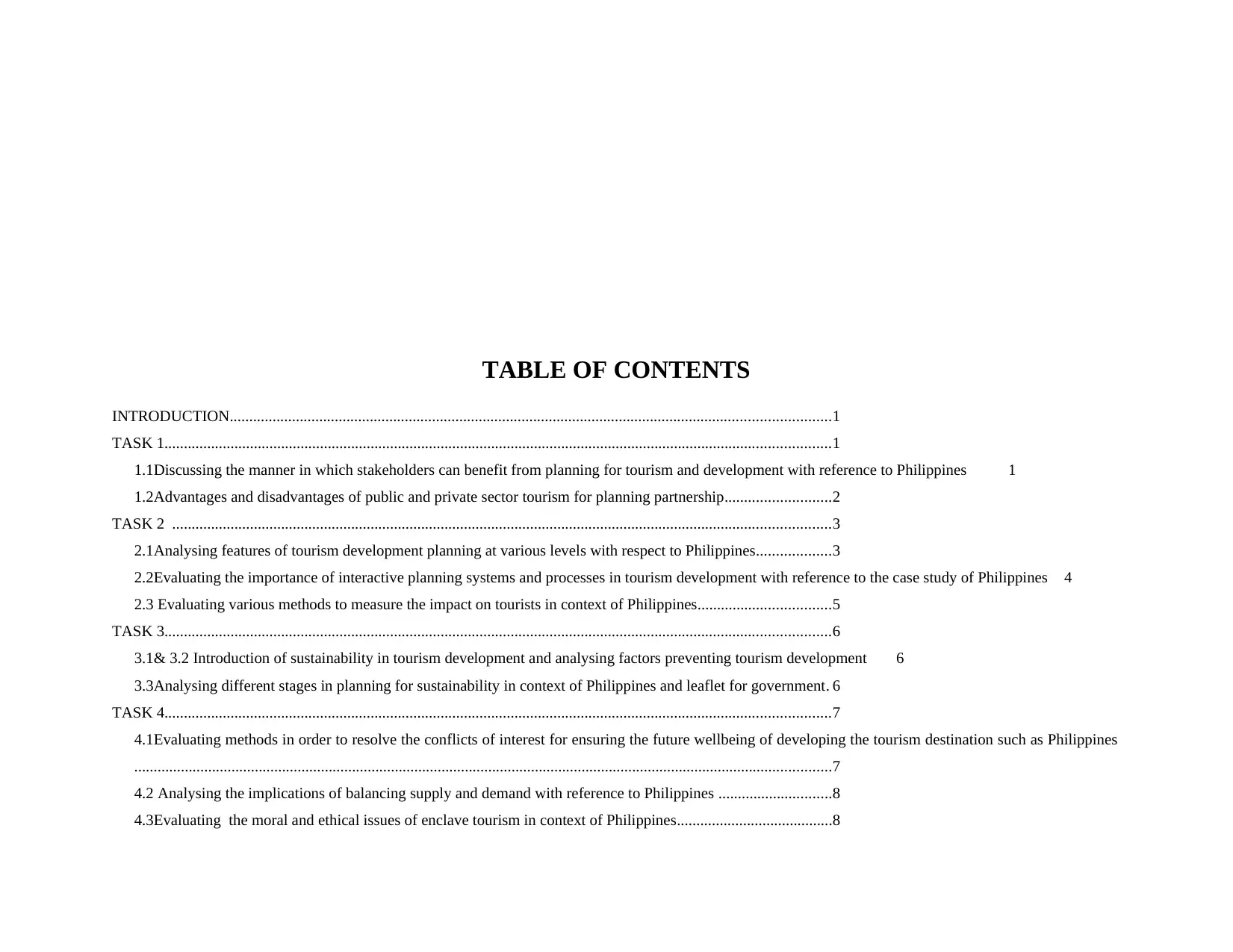
TABLE OF CONTENTS
INTRODUCTION..........................................................................................................................................................1
TASK 1...........................................................................................................................................................................1
1.1Discussing the manner in which stakeholders can benefit from planning for tourism and development with reference to Philippines 1
1.2Advantages and disadvantages of public and private sector tourism for planning partnership...........................2
TASK 2 .........................................................................................................................................................................3
2.1Analysing features of tourism development planning at various levels with respect to Philippines...................3
2.2Evaluating the importance of interactive planning systems and processes in tourism development with reference to the case study of Philippines 4
2.3 Evaluating various methods to measure the impact on tourists in context of Philippines..................................5
TASK 3...........................................................................................................................................................................6
3.1& 3.2 Introduction of sustainability in tourism development and analysing factors preventing tourism development 6
3.3Analysing different stages in planning for sustainability in context of Philippines and leaflet for government. 6
TASK 4...........................................................................................................................................................................7
4.1Evaluating methods in order to resolve the conflicts of interest for ensuring the future wellbeing of developing the tourism destination such as Philippines
...................................................................................................................................................................................7
4.2 Analysing the implications of balancing supply and demand with reference to Philippines .............................8
4.3Evaluating the moral and ethical issues of enclave tourism in context of Philippines........................................8
INTRODUCTION..........................................................................................................................................................1
TASK 1...........................................................................................................................................................................1
1.1Discussing the manner in which stakeholders can benefit from planning for tourism and development with reference to Philippines 1
1.2Advantages and disadvantages of public and private sector tourism for planning partnership...........................2
TASK 2 .........................................................................................................................................................................3
2.1Analysing features of tourism development planning at various levels with respect to Philippines...................3
2.2Evaluating the importance of interactive planning systems and processes in tourism development with reference to the case study of Philippines 4
2.3 Evaluating various methods to measure the impact on tourists in context of Philippines..................................5
TASK 3...........................................................................................................................................................................6
3.1& 3.2 Introduction of sustainability in tourism development and analysing factors preventing tourism development 6
3.3Analysing different stages in planning for sustainability in context of Philippines and leaflet for government. 6
TASK 4...........................................................................................................................................................................7
4.1Evaluating methods in order to resolve the conflicts of interest for ensuring the future wellbeing of developing the tourism destination such as Philippines
...................................................................................................................................................................................7
4.2 Analysing the implications of balancing supply and demand with reference to Philippines .............................8
4.3Evaluating the moral and ethical issues of enclave tourism in context of Philippines........................................8
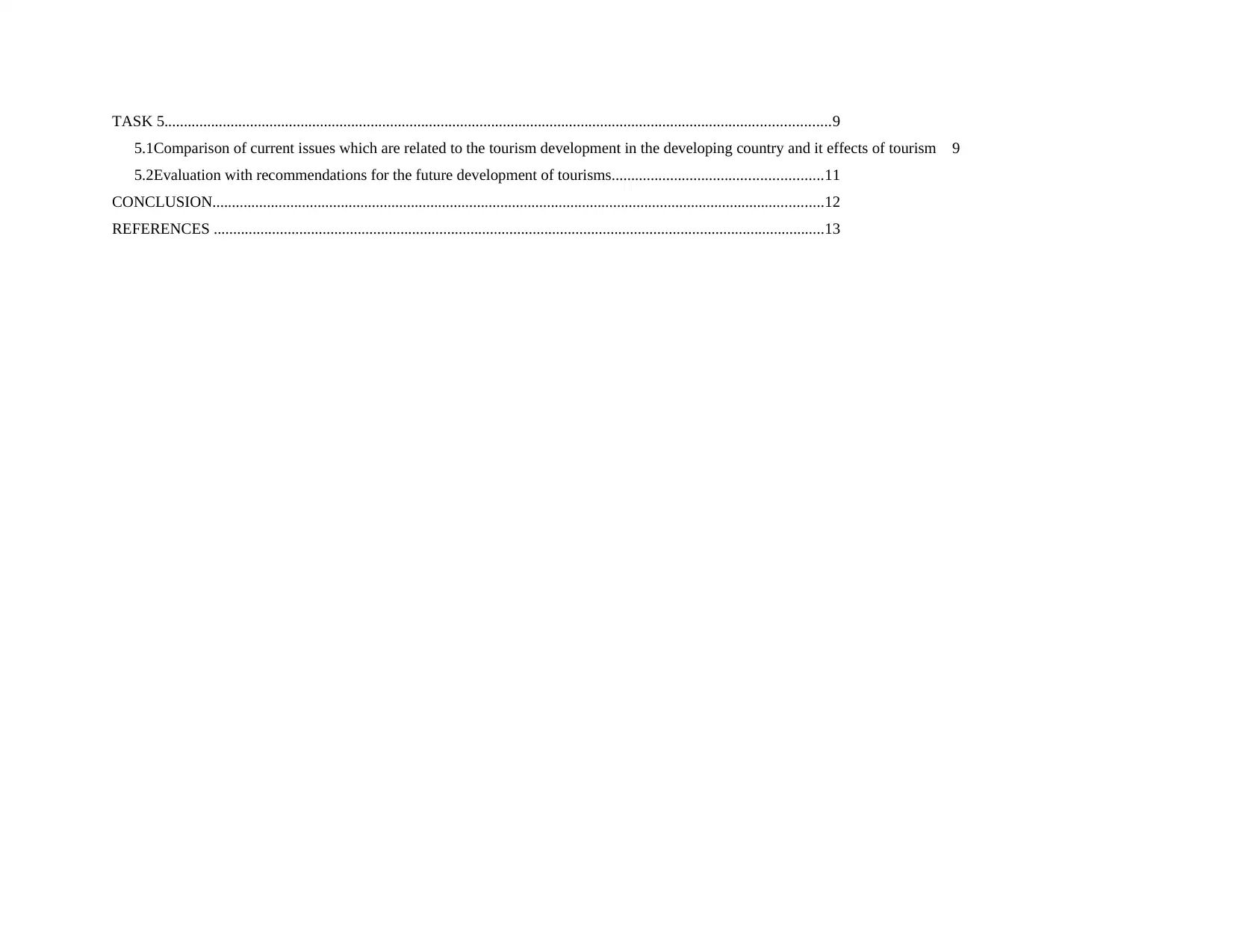
TASK 5...........................................................................................................................................................................9
5.1Comparison of current issues which are related to the tourism development in the developing country and it effects of tourism 9
5.2Evaluation with recommendations for the future development of tourisms......................................................11
CONCLUSION.............................................................................................................................................................12
REFERENCES .............................................................................................................................................................13
5.1Comparison of current issues which are related to the tourism development in the developing country and it effects of tourism 9
5.2Evaluation with recommendations for the future development of tourisms......................................................11
CONCLUSION.............................................................................................................................................................12
REFERENCES .............................................................................................................................................................13
⊘ This is a preview!⊘
Do you want full access?
Subscribe today to unlock all pages.

Trusted by 1+ million students worldwide
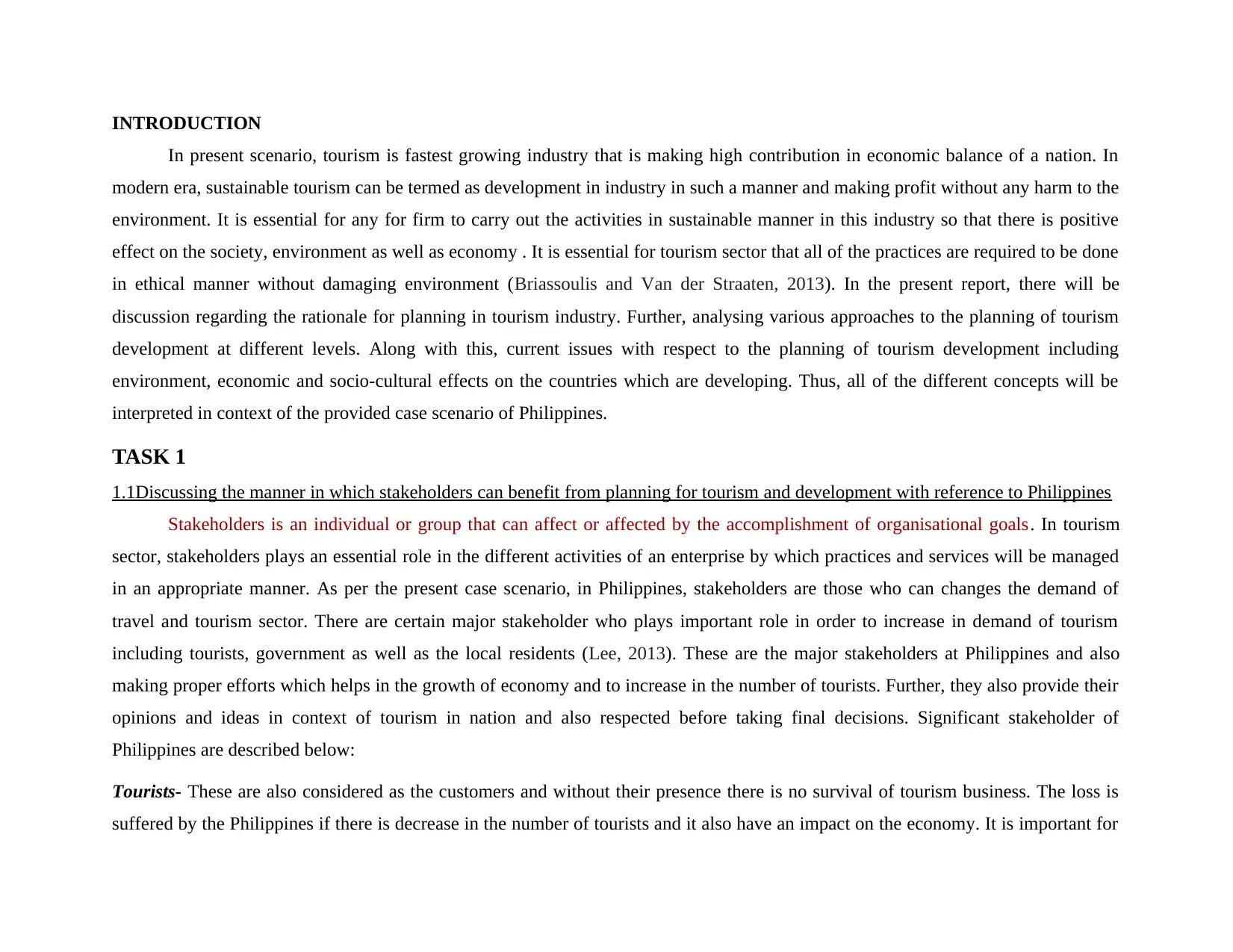
INTRODUCTION
In present scenario, tourism is fastest growing industry that is making high contribution in economic balance of a nation. In
modern era, sustainable tourism can be termed as development in industry in such a manner and making profit without any harm to the
environment. It is essential for any for firm to carry out the activities in sustainable manner in this industry so that there is positive
effect on the society, environment as well as economy . It is essential for tourism sector that all of the practices are required to be done
in ethical manner without damaging environment (Briassoulis and Van der Straaten, 2013). In the present report, there will be
discussion regarding the rationale for planning in tourism industry. Further, analysing various approaches to the planning of tourism
development at different levels. Along with this, current issues with respect to the planning of tourism development including
environment, economic and socio-cultural effects on the countries which are developing. Thus, all of the different concepts will be
interpreted in context of the provided case scenario of Philippines.
TASK 1
1.1Discussing the manner in which stakeholders can benefit from planning for tourism and development with reference to Philippines
Stakeholders is an individual or group that can affect or affected by the accomplishment of organisational goals. In tourism
sector, stakeholders plays an essential role in the different activities of an enterprise by which practices and services will be managed
in an appropriate manner. As per the present case scenario, in Philippines, stakeholders are those who can changes the demand of
travel and tourism sector. There are certain major stakeholder who plays important role in order to increase in demand of tourism
including tourists, government as well as the local residents (Lee, 2013). These are the major stakeholders at Philippines and also
making proper efforts which helps in the growth of economy and to increase in the number of tourists. Further, they also provide their
opinions and ideas in context of tourism in nation and also respected before taking final decisions. Significant stakeholder of
Philippines are described below:
Tourists- These are also considered as the customers and without their presence there is no survival of tourism business. The loss is
suffered by the Philippines if there is decrease in the number of tourists and it also have an impact on the economy. It is important for
In present scenario, tourism is fastest growing industry that is making high contribution in economic balance of a nation. In
modern era, sustainable tourism can be termed as development in industry in such a manner and making profit without any harm to the
environment. It is essential for any for firm to carry out the activities in sustainable manner in this industry so that there is positive
effect on the society, environment as well as economy . It is essential for tourism sector that all of the practices are required to be done
in ethical manner without damaging environment (Briassoulis and Van der Straaten, 2013). In the present report, there will be
discussion regarding the rationale for planning in tourism industry. Further, analysing various approaches to the planning of tourism
development at different levels. Along with this, current issues with respect to the planning of tourism development including
environment, economic and socio-cultural effects on the countries which are developing. Thus, all of the different concepts will be
interpreted in context of the provided case scenario of Philippines.
TASK 1
1.1Discussing the manner in which stakeholders can benefit from planning for tourism and development with reference to Philippines
Stakeholders is an individual or group that can affect or affected by the accomplishment of organisational goals. In tourism
sector, stakeholders plays an essential role in the different activities of an enterprise by which practices and services will be managed
in an appropriate manner. As per the present case scenario, in Philippines, stakeholders are those who can changes the demand of
travel and tourism sector. There are certain major stakeholder who plays important role in order to increase in demand of tourism
including tourists, government as well as the local residents (Lee, 2013). These are the major stakeholders at Philippines and also
making proper efforts which helps in the growth of economy and to increase in the number of tourists. Further, they also provide their
opinions and ideas in context of tourism in nation and also respected before taking final decisions. Significant stakeholder of
Philippines are described below:
Tourists- These are also considered as the customers and without their presence there is no survival of tourism business. The loss is
suffered by the Philippines if there is decrease in the number of tourists and it also have an impact on the economy. It is important for
Paraphrase This Document
Need a fresh take? Get an instant paraphrase of this document with our AI Paraphraser
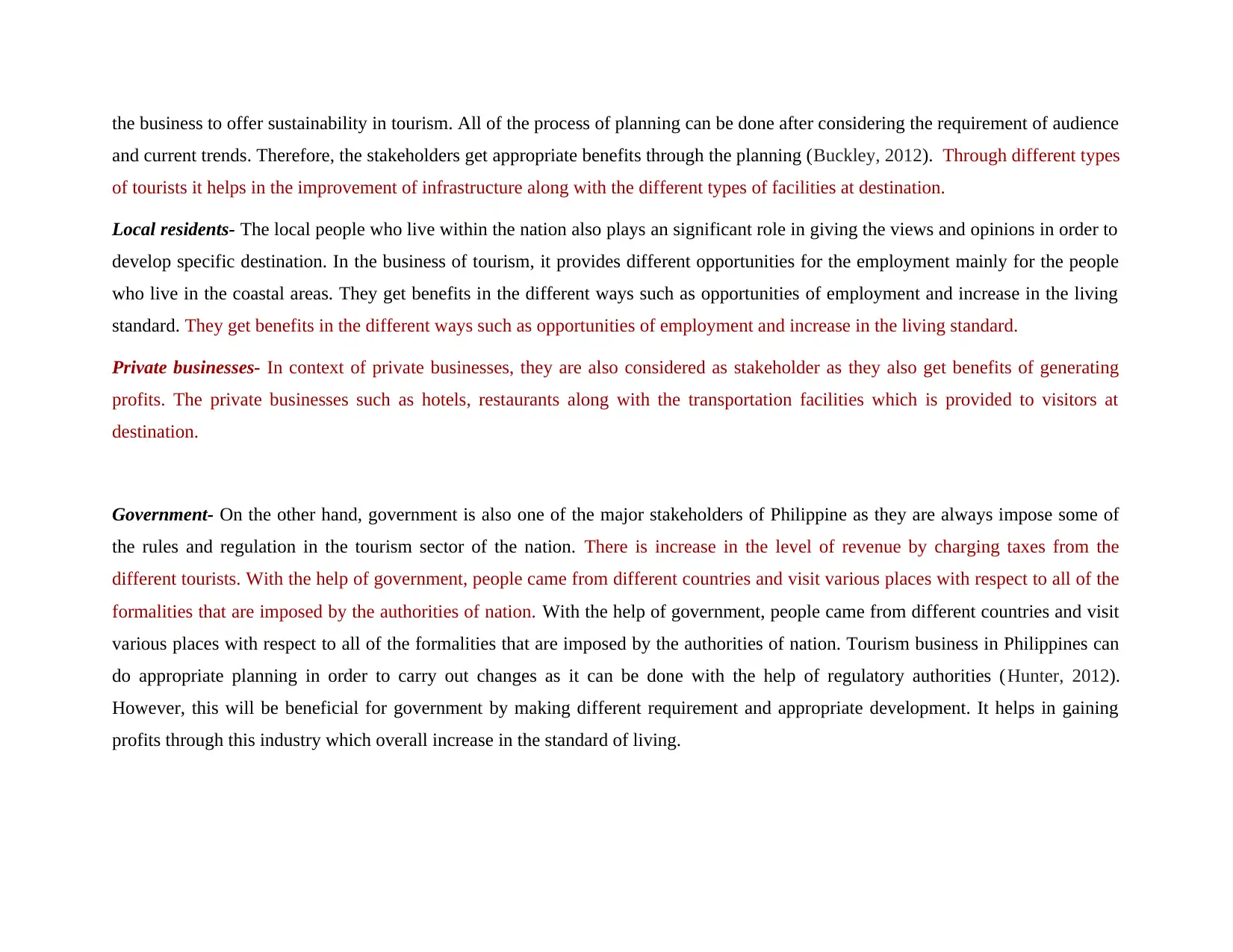
the business to offer sustainability in tourism. All of the process of planning can be done after considering the requirement of audience
and current trends. Therefore, the stakeholders get appropriate benefits through the planning (Buckley, 2012). Through different types
of tourists it helps in the improvement of infrastructure along with the different types of facilities at destination.
Local residents- The local people who live within the nation also plays an significant role in giving the views and opinions in order to
develop specific destination. In the business of tourism, it provides different opportunities for the employment mainly for the people
who live in the coastal areas. They get benefits in the different ways such as opportunities of employment and increase in the living
standard. They get benefits in the different ways such as opportunities of employment and increase in the living standard.
Private businesses- In context of private businesses, they are also considered as stakeholder as they also get benefits of generating
profits. The private businesses such as hotels, restaurants along with the transportation facilities which is provided to visitors at
destination.
Government- On the other hand, government is also one of the major stakeholders of Philippine as they are always impose some of
the rules and regulation in the tourism sector of the nation. There is increase in the level of revenue by charging taxes from the
different tourists. With the help of government, people came from different countries and visit various places with respect to all of the
formalities that are imposed by the authorities of nation. With the help of government, people came from different countries and visit
various places with respect to all of the formalities that are imposed by the authorities of nation. Tourism business in Philippines can
do appropriate planning in order to carry out changes as it can be done with the help of regulatory authorities (Hunter, 2012).
However, this will be beneficial for government by making different requirement and appropriate development. It helps in gaining
profits through this industry which overall increase in the standard of living.
and current trends. Therefore, the stakeholders get appropriate benefits through the planning (Buckley, 2012). Through different types
of tourists it helps in the improvement of infrastructure along with the different types of facilities at destination.
Local residents- The local people who live within the nation also plays an significant role in giving the views and opinions in order to
develop specific destination. In the business of tourism, it provides different opportunities for the employment mainly for the people
who live in the coastal areas. They get benefits in the different ways such as opportunities of employment and increase in the living
standard. They get benefits in the different ways such as opportunities of employment and increase in the living standard.
Private businesses- In context of private businesses, they are also considered as stakeholder as they also get benefits of generating
profits. The private businesses such as hotels, restaurants along with the transportation facilities which is provided to visitors at
destination.
Government- On the other hand, government is also one of the major stakeholders of Philippine as they are always impose some of
the rules and regulation in the tourism sector of the nation. There is increase in the level of revenue by charging taxes from the
different tourists. With the help of government, people came from different countries and visit various places with respect to all of the
formalities that are imposed by the authorities of nation. With the help of government, people came from different countries and visit
various places with respect to all of the formalities that are imposed by the authorities of nation. Tourism business in Philippines can
do appropriate planning in order to carry out changes as it can be done with the help of regulatory authorities (Hunter, 2012).
However, this will be beneficial for government by making different requirement and appropriate development. It helps in gaining
profits through this industry which overall increase in the standard of living.
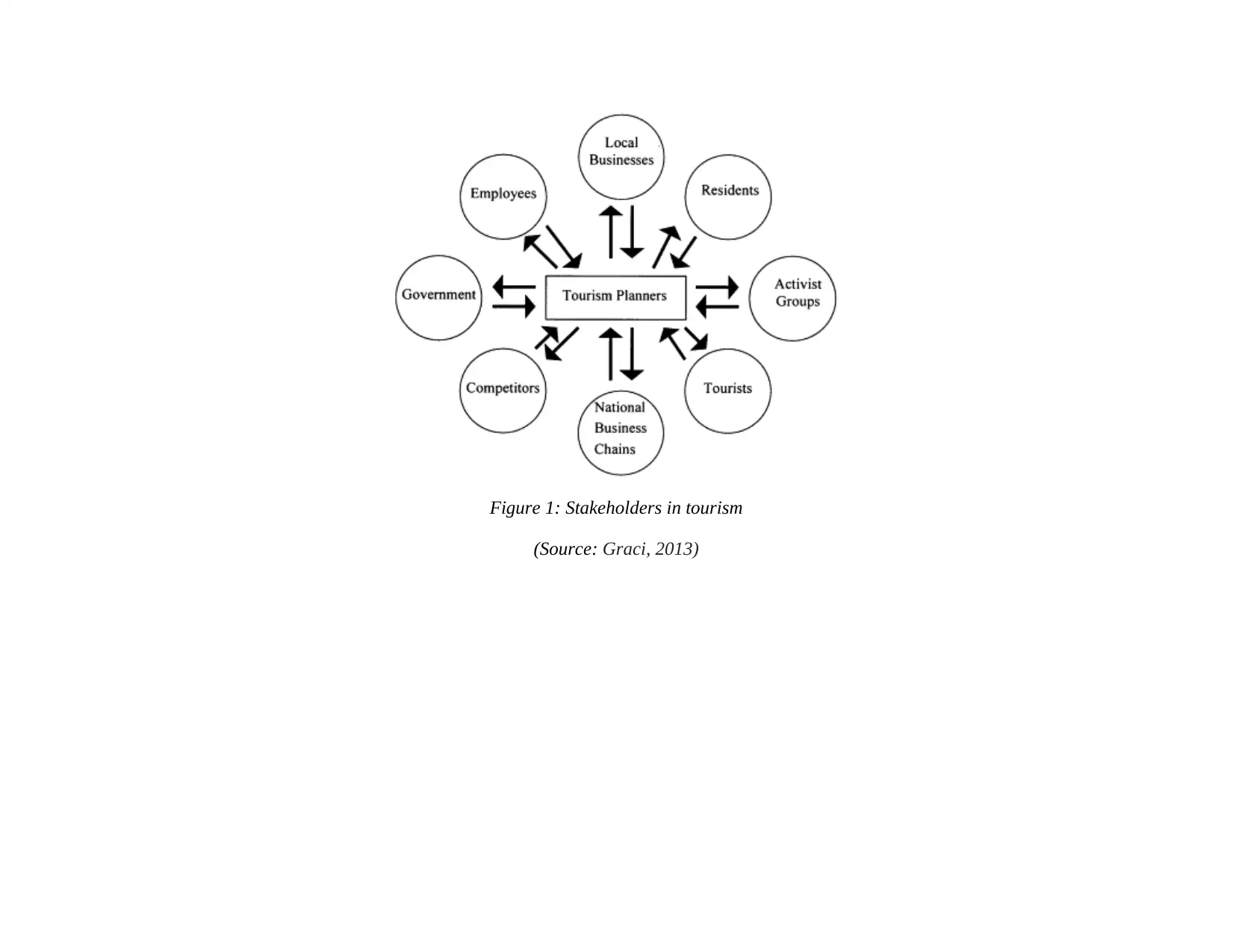
Figure 1: Stakeholders in tourism
(Source: Graci, 2013)
(Source: Graci, 2013)
⊘ This is a preview!⊘
Do you want full access?
Subscribe today to unlock all pages.

Trusted by 1+ million students worldwide
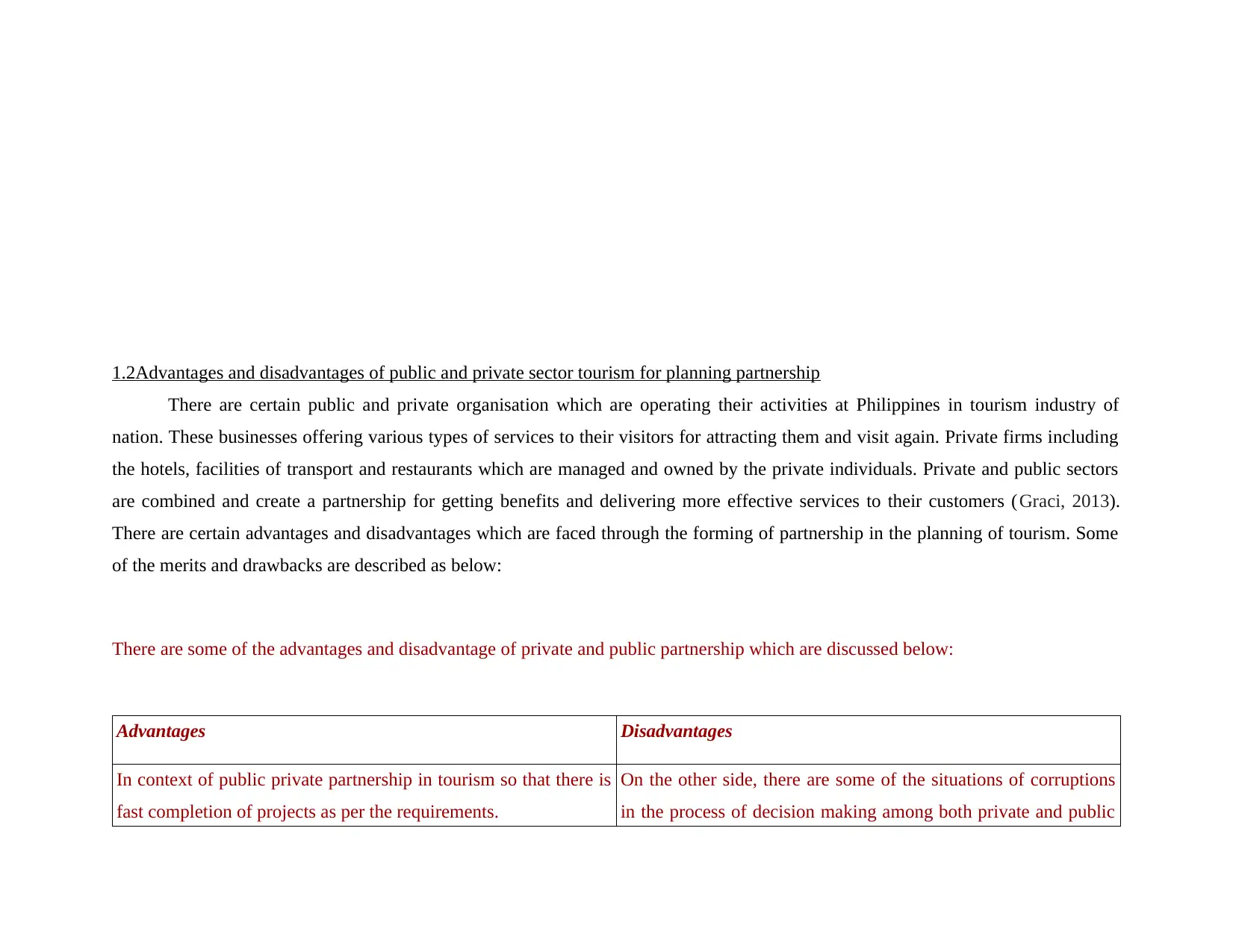
1.2Advantages and disadvantages of public and private sector tourism for planning partnership
There are certain public and private organisation which are operating their activities at Philippines in tourism industry of
nation. These businesses offering various types of services to their visitors for attracting them and visit again. Private firms including
the hotels, facilities of transport and restaurants which are managed and owned by the private individuals. Private and public sectors
are combined and create a partnership for getting benefits and delivering more effective services to their customers (Graci, 2013).
There are certain advantages and disadvantages which are faced through the forming of partnership in the planning of tourism. Some
of the merits and drawbacks are described as below:
There are some of the advantages and disadvantage of private and public partnership which are discussed below:
Advantages Disadvantages
In context of public private partnership in tourism so that there is
fast completion of projects as per the requirements.
On the other side, there are some of the situations of corruptions
in the process of decision making among both private and public
There are certain public and private organisation which are operating their activities at Philippines in tourism industry of
nation. These businesses offering various types of services to their visitors for attracting them and visit again. Private firms including
the hotels, facilities of transport and restaurants which are managed and owned by the private individuals. Private and public sectors
are combined and create a partnership for getting benefits and delivering more effective services to their customers (Graci, 2013).
There are certain advantages and disadvantages which are faced through the forming of partnership in the planning of tourism. Some
of the merits and drawbacks are described as below:
There are some of the advantages and disadvantage of private and public partnership which are discussed below:
Advantages Disadvantages
In context of public private partnership in tourism so that there is
fast completion of projects as per the requirements.
On the other side, there are some of the situations of corruptions
in the process of decision making among both private and public
Paraphrase This Document
Need a fresh take? Get an instant paraphrase of this document with our AI Paraphraser
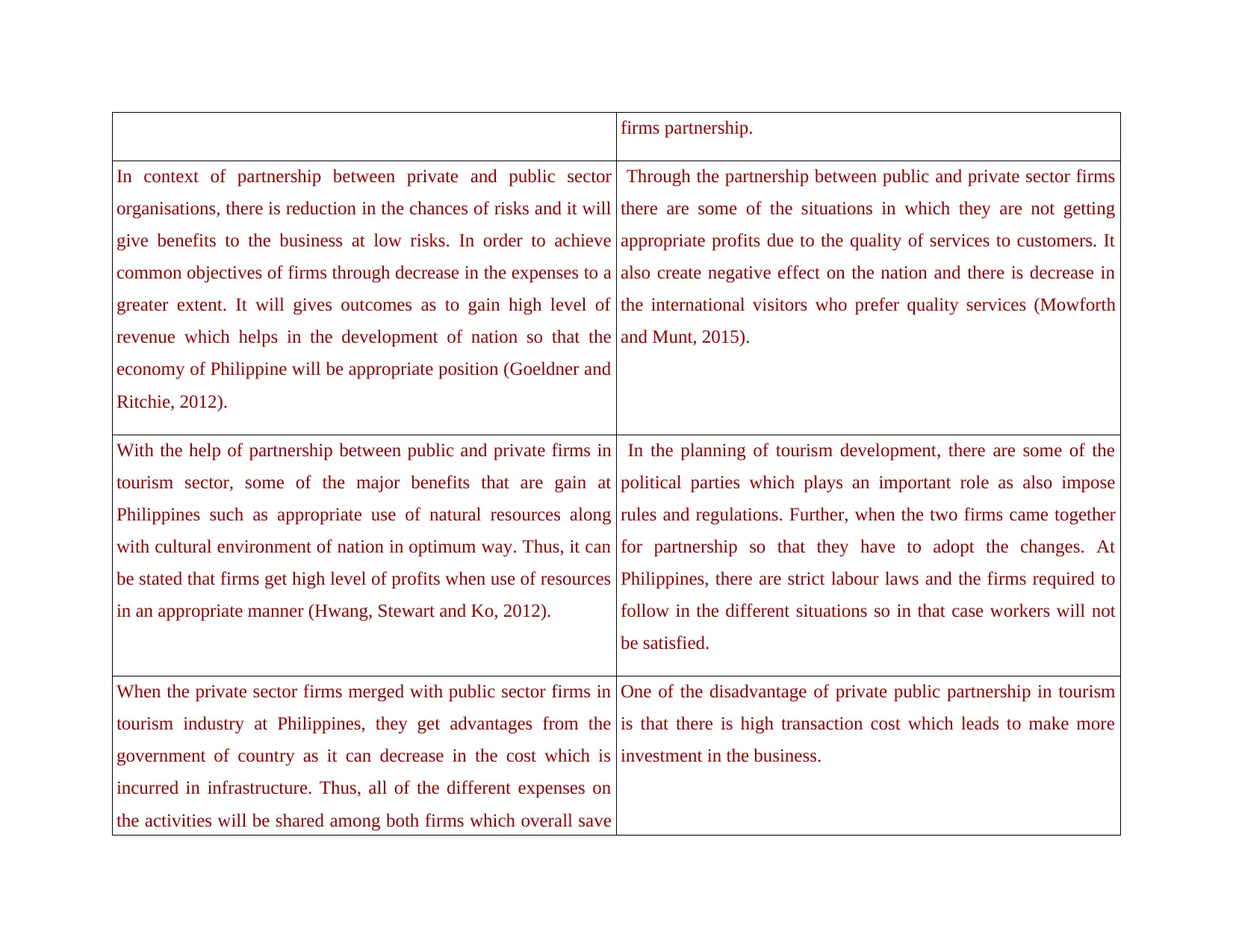
firms partnership.
In context of partnership between private and public sector
organisations, there is reduction in the chances of risks and it will
give benefits to the business at low risks. In order to achieve
common objectives of firms through decrease in the expenses to a
greater extent. It will gives outcomes as to gain high level of
revenue which helps in the development of nation so that the
economy of Philippine will be appropriate position (Goeldner and
Ritchie, 2012).
Through the partnership between public and private sector firms
there are some of the situations in which they are not getting
appropriate profits due to the quality of services to customers. It
also create negative effect on the nation and there is decrease in
the international visitors who prefer quality services (Mowforth
and Munt, 2015).
With the help of partnership between public and private firms in
tourism sector, some of the major benefits that are gain at
Philippines such as appropriate use of natural resources along
with cultural environment of nation in optimum way. Thus, it can
be stated that firms get high level of profits when use of resources
in an appropriate manner (Hwang, Stewart and Ko, 2012).
In the planning of tourism development, there are some of the
political parties which plays an important role as also impose
rules and regulations. Further, when the two firms came together
for partnership so that they have to adopt the changes. At
Philippines, there are strict labour laws and the firms required to
follow in the different situations so in that case workers will not
be satisfied.
When the private sector firms merged with public sector firms in
tourism industry at Philippines, they get advantages from the
government of country as it can decrease in the cost which is
incurred in infrastructure. Thus, all of the different expenses on
the activities will be shared among both firms which overall save
One of the disadvantage of private public partnership in tourism
is that there is high transaction cost which leads to make more
investment in the business.
In context of partnership between private and public sector
organisations, there is reduction in the chances of risks and it will
give benefits to the business at low risks. In order to achieve
common objectives of firms through decrease in the expenses to a
greater extent. It will gives outcomes as to gain high level of
revenue which helps in the development of nation so that the
economy of Philippine will be appropriate position (Goeldner and
Ritchie, 2012).
Through the partnership between public and private sector firms
there are some of the situations in which they are not getting
appropriate profits due to the quality of services to customers. It
also create negative effect on the nation and there is decrease in
the international visitors who prefer quality services (Mowforth
and Munt, 2015).
With the help of partnership between public and private firms in
tourism sector, some of the major benefits that are gain at
Philippines such as appropriate use of natural resources along
with cultural environment of nation in optimum way. Thus, it can
be stated that firms get high level of profits when use of resources
in an appropriate manner (Hwang, Stewart and Ko, 2012).
In the planning of tourism development, there are some of the
political parties which plays an important role as also impose
rules and regulations. Further, when the two firms came together
for partnership so that they have to adopt the changes. At
Philippines, there are strict labour laws and the firms required to
follow in the different situations so in that case workers will not
be satisfied.
When the private sector firms merged with public sector firms in
tourism industry at Philippines, they get advantages from the
government of country as it can decrease in the cost which is
incurred in infrastructure. Thus, all of the different expenses on
the activities will be shared among both firms which overall save
One of the disadvantage of private public partnership in tourism
is that there is high transaction cost which leads to make more
investment in the business.
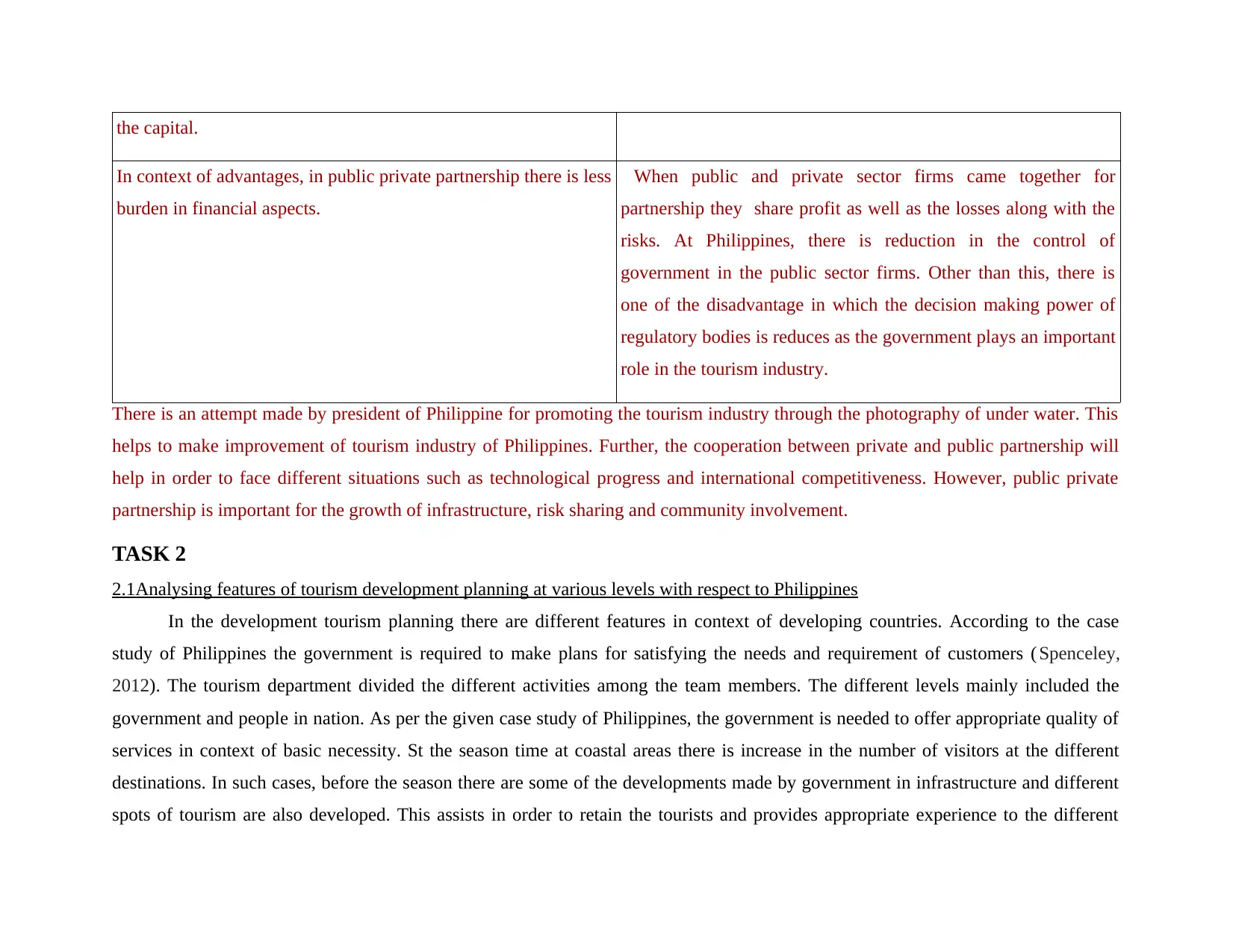
the capital.
In context of advantages, in public private partnership there is less
burden in financial aspects.
When public and private sector firms came together for
partnership they share profit as well as the losses along with the
risks. At Philippines, there is reduction in the control of
government in the public sector firms. Other than this, there is
one of the disadvantage in which the decision making power of
regulatory bodies is reduces as the government plays an important
role in the tourism industry.
There is an attempt made by president of Philippine for promoting the tourism industry through the photography of under water. This
helps to make improvement of tourism industry of Philippines. Further, the cooperation between private and public partnership will
help in order to face different situations such as technological progress and international competitiveness. However, public private
partnership is important for the growth of infrastructure, risk sharing and community involvement.
TASK 2
2.1Analysing features of tourism development planning at various levels with respect to Philippines
In the development tourism planning there are different features in context of developing countries. According to the case
study of Philippines the government is required to make plans for satisfying the needs and requirement of customers ( Spenceley,
2012). The tourism department divided the different activities among the team members. The different levels mainly included the
government and people in nation. As per the given case study of Philippines, the government is needed to offer appropriate quality of
services in context of basic necessity. St the season time at coastal areas there is increase in the number of visitors at the different
destinations. In such cases, before the season there are some of the developments made by government in infrastructure and different
spots of tourism are also developed. This assists in order to retain the tourists and provides appropriate experience to the different
In context of advantages, in public private partnership there is less
burden in financial aspects.
When public and private sector firms came together for
partnership they share profit as well as the losses along with the
risks. At Philippines, there is reduction in the control of
government in the public sector firms. Other than this, there is
one of the disadvantage in which the decision making power of
regulatory bodies is reduces as the government plays an important
role in the tourism industry.
There is an attempt made by president of Philippine for promoting the tourism industry through the photography of under water. This
helps to make improvement of tourism industry of Philippines. Further, the cooperation between private and public partnership will
help in order to face different situations such as technological progress and international competitiveness. However, public private
partnership is important for the growth of infrastructure, risk sharing and community involvement.
TASK 2
2.1Analysing features of tourism development planning at various levels with respect to Philippines
In the development tourism planning there are different features in context of developing countries. According to the case
study of Philippines the government is required to make plans for satisfying the needs and requirement of customers ( Spenceley,
2012). The tourism department divided the different activities among the team members. The different levels mainly included the
government and people in nation. As per the given case study of Philippines, the government is needed to offer appropriate quality of
services in context of basic necessity. St the season time at coastal areas there is increase in the number of visitors at the different
destinations. In such cases, before the season there are some of the developments made by government in infrastructure and different
spots of tourism are also developed. This assists in order to retain the tourists and provides appropriate experience to the different
⊘ This is a preview!⊘
Do you want full access?
Subscribe today to unlock all pages.

Trusted by 1+ million students worldwide
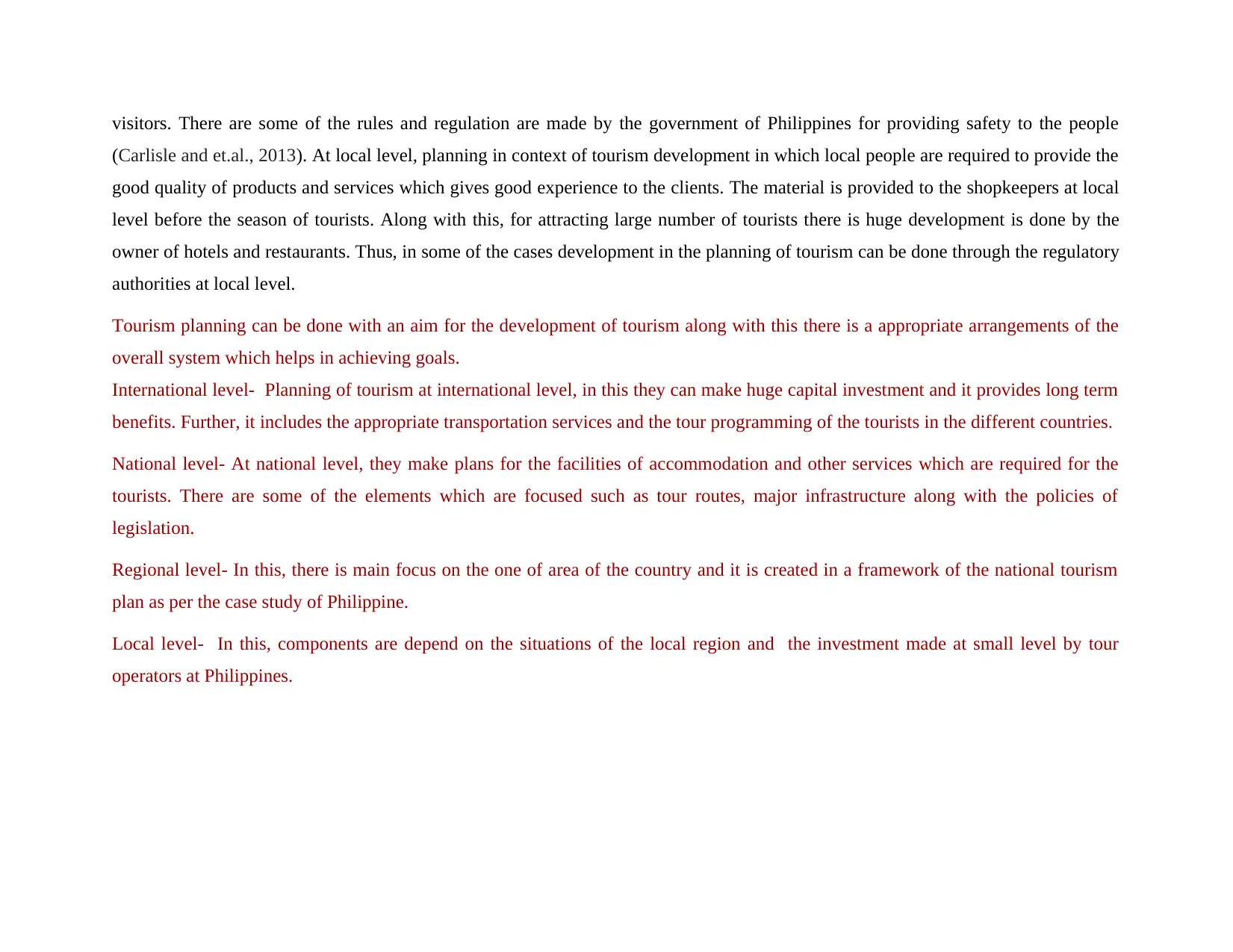
visitors. There are some of the rules and regulation are made by the government of Philippines for providing safety to the people
(Carlisle and et.al., 2013). At local level, planning in context of tourism development in which local people are required to provide the
good quality of products and services which gives good experience to the clients. The material is provided to the shopkeepers at local
level before the season of tourists. Along with this, for attracting large number of tourists there is huge development is done by the
owner of hotels and restaurants. Thus, in some of the cases development in the planning of tourism can be done through the regulatory
authorities at local level.
Tourism planning can be done with an aim for the development of tourism along with this there is a appropriate arrangements of the
overall system which helps in achieving goals.
International level- Planning of tourism at international level, in this they can make huge capital investment and it provides long term
benefits. Further, it includes the appropriate transportation services and the tour programming of the tourists in the different countries.
National level- At national level, they make plans for the facilities of accommodation and other services which are required for the
tourists. There are some of the elements which are focused such as tour routes, major infrastructure along with the policies of
legislation.
Regional level- In this, there is main focus on the one of area of the country and it is created in a framework of the national tourism
plan as per the case study of Philippine.
Local level- In this, components are depend on the situations of the local region and the investment made at small level by tour
operators at Philippines.
(Carlisle and et.al., 2013). At local level, planning in context of tourism development in which local people are required to provide the
good quality of products and services which gives good experience to the clients. The material is provided to the shopkeepers at local
level before the season of tourists. Along with this, for attracting large number of tourists there is huge development is done by the
owner of hotels and restaurants. Thus, in some of the cases development in the planning of tourism can be done through the regulatory
authorities at local level.
Tourism planning can be done with an aim for the development of tourism along with this there is a appropriate arrangements of the
overall system which helps in achieving goals.
International level- Planning of tourism at international level, in this they can make huge capital investment and it provides long term
benefits. Further, it includes the appropriate transportation services and the tour programming of the tourists in the different countries.
National level- At national level, they make plans for the facilities of accommodation and other services which are required for the
tourists. There are some of the elements which are focused such as tour routes, major infrastructure along with the policies of
legislation.
Regional level- In this, there is main focus on the one of area of the country and it is created in a framework of the national tourism
plan as per the case study of Philippine.
Local level- In this, components are depend on the situations of the local region and the investment made at small level by tour
operators at Philippines.
Paraphrase This Document
Need a fresh take? Get an instant paraphrase of this document with our AI Paraphraser
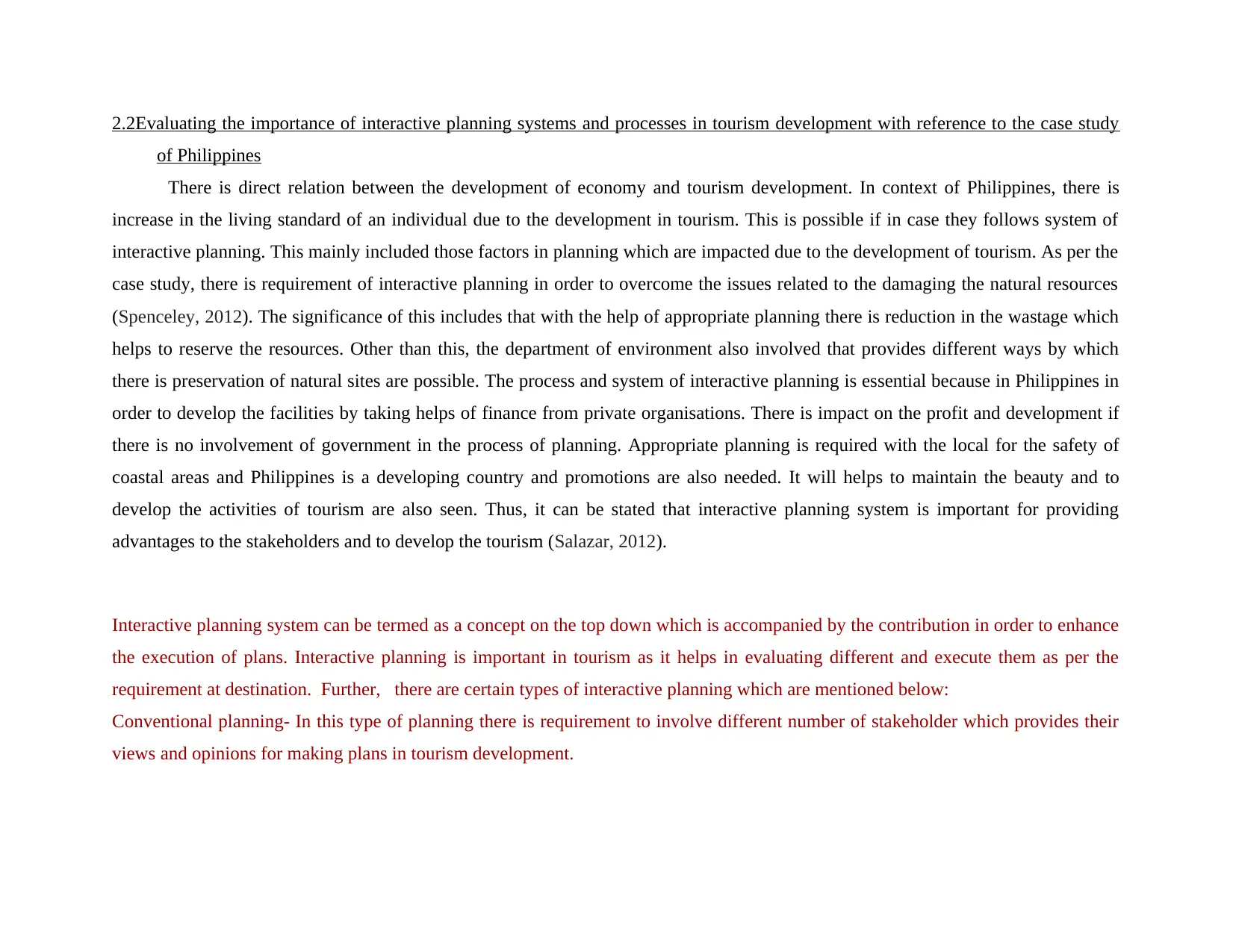
2.2Evaluating the importance of interactive planning systems and processes in tourism development with reference to the case study
of Philippines
There is direct relation between the development of economy and tourism development. In context of Philippines, there is
increase in the living standard of an individual due to the development in tourism. This is possible if in case they follows system of
interactive planning. This mainly included those factors in planning which are impacted due to the development of tourism. As per the
case study, there is requirement of interactive planning in order to overcome the issues related to the damaging the natural resources
(Spenceley, 2012). The significance of this includes that with the help of appropriate planning there is reduction in the wastage which
helps to reserve the resources. Other than this, the department of environment also involved that provides different ways by which
there is preservation of natural sites are possible. The process and system of interactive planning is essential because in Philippines in
order to develop the facilities by taking helps of finance from private organisations. There is impact on the profit and development if
there is no involvement of government in the process of planning. Appropriate planning is required with the local for the safety of
coastal areas and Philippines is a developing country and promotions are also needed. It will helps to maintain the beauty and to
develop the activities of tourism are also seen. Thus, it can be stated that interactive planning system is important for providing
advantages to the stakeholders and to develop the tourism (Salazar, 2012).
Interactive planning system can be termed as a concept on the top down which is accompanied by the contribution in order to enhance
the execution of plans. Interactive planning is important in tourism as it helps in evaluating different and execute them as per the
requirement at destination. Further, there are certain types of interactive planning which are mentioned below:
Conventional planning- In this type of planning there is requirement to involve different number of stakeholder which provides their
views and opinions for making plans in tourism development.
of Philippines
There is direct relation between the development of economy and tourism development. In context of Philippines, there is
increase in the living standard of an individual due to the development in tourism. This is possible if in case they follows system of
interactive planning. This mainly included those factors in planning which are impacted due to the development of tourism. As per the
case study, there is requirement of interactive planning in order to overcome the issues related to the damaging the natural resources
(Spenceley, 2012). The significance of this includes that with the help of appropriate planning there is reduction in the wastage which
helps to reserve the resources. Other than this, the department of environment also involved that provides different ways by which
there is preservation of natural sites are possible. The process and system of interactive planning is essential because in Philippines in
order to develop the facilities by taking helps of finance from private organisations. There is impact on the profit and development if
there is no involvement of government in the process of planning. Appropriate planning is required with the local for the safety of
coastal areas and Philippines is a developing country and promotions are also needed. It will helps to maintain the beauty and to
develop the activities of tourism are also seen. Thus, it can be stated that interactive planning system is important for providing
advantages to the stakeholders and to develop the tourism (Salazar, 2012).
Interactive planning system can be termed as a concept on the top down which is accompanied by the contribution in order to enhance
the execution of plans. Interactive planning is important in tourism as it helps in evaluating different and execute them as per the
requirement at destination. Further, there are certain types of interactive planning which are mentioned below:
Conventional planning- In this type of planning there is requirement to involve different number of stakeholder which provides their
views and opinions for making plans in tourism development.
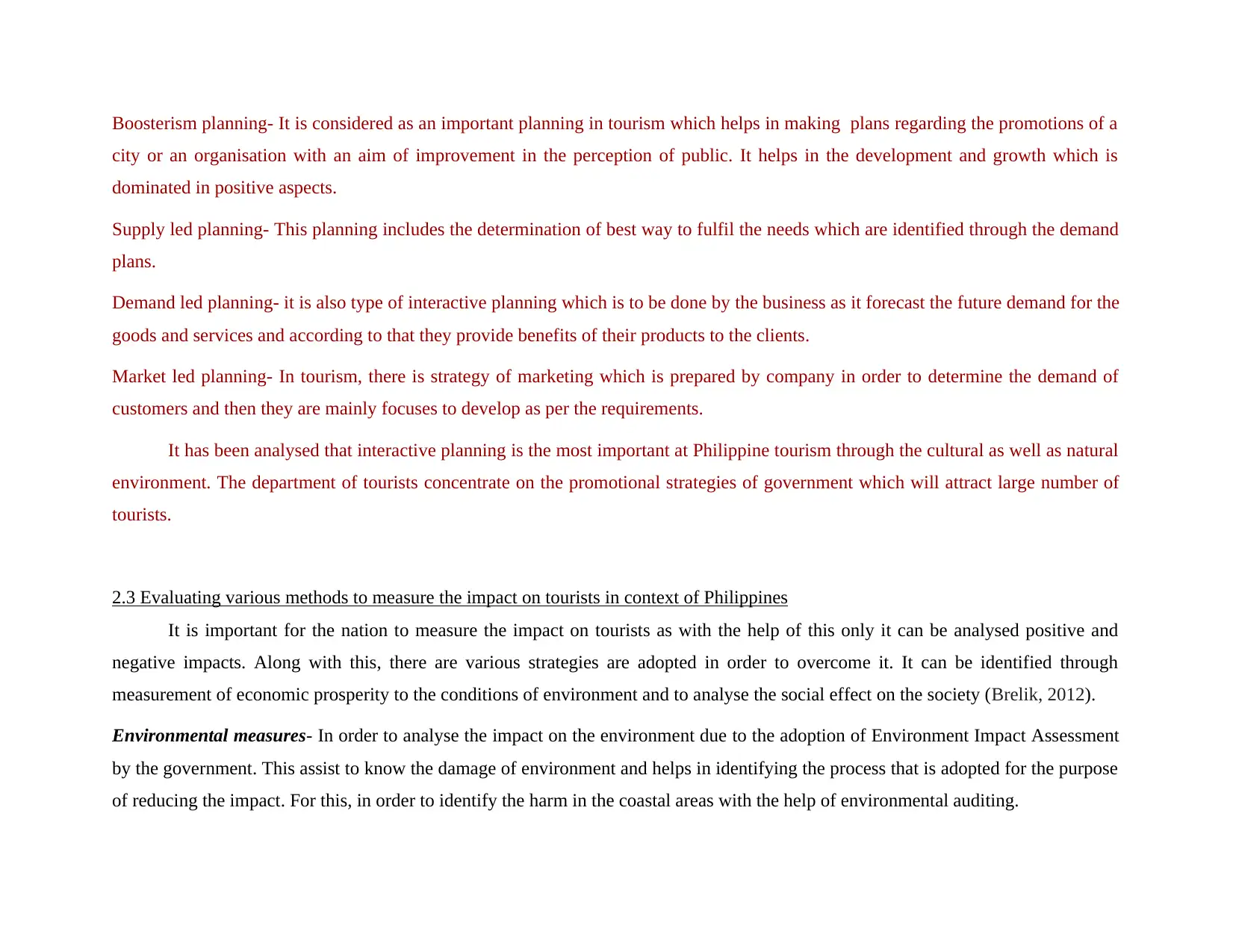
Boosterism planning- It is considered as an important planning in tourism which helps in making plans regarding the promotions of a
city or an organisation with an aim of improvement in the perception of public. It helps in the development and growth which is
dominated in positive aspects.
Supply led planning- This planning includes the determination of best way to fulfil the needs which are identified through the demand
plans.
Demand led planning- it is also type of interactive planning which is to be done by the business as it forecast the future demand for the
goods and services and according to that they provide benefits of their products to the clients.
Market led planning- In tourism, there is strategy of marketing which is prepared by company in order to determine the demand of
customers and then they are mainly focuses to develop as per the requirements.
It has been analysed that interactive planning is the most important at Philippine tourism through the cultural as well as natural
environment. The department of tourists concentrate on the promotional strategies of government which will attract large number of
tourists.
2.3 Evaluating various methods to measure the impact on tourists in context of Philippines
It is important for the nation to measure the impact on tourists as with the help of this only it can be analysed positive and
negative impacts. Along with this, there are various strategies are adopted in order to overcome it. It can be identified through
measurement of economic prosperity to the conditions of environment and to analyse the social effect on the society (Brelik, 2012).
Environmental measures- In order to analyse the impact on the environment due to the adoption of Environment Impact Assessment
by the government. This assist to know the damage of environment and helps in identifying the process that is adopted for the purpose
of reducing the impact. For this, in order to identify the harm in the coastal areas with the help of environmental auditing.
city or an organisation with an aim of improvement in the perception of public. It helps in the development and growth which is
dominated in positive aspects.
Supply led planning- This planning includes the determination of best way to fulfil the needs which are identified through the demand
plans.
Demand led planning- it is also type of interactive planning which is to be done by the business as it forecast the future demand for the
goods and services and according to that they provide benefits of their products to the clients.
Market led planning- In tourism, there is strategy of marketing which is prepared by company in order to determine the demand of
customers and then they are mainly focuses to develop as per the requirements.
It has been analysed that interactive planning is the most important at Philippine tourism through the cultural as well as natural
environment. The department of tourists concentrate on the promotional strategies of government which will attract large number of
tourists.
2.3 Evaluating various methods to measure the impact on tourists in context of Philippines
It is important for the nation to measure the impact on tourists as with the help of this only it can be analysed positive and
negative impacts. Along with this, there are various strategies are adopted in order to overcome it. It can be identified through
measurement of economic prosperity to the conditions of environment and to analyse the social effect on the society (Brelik, 2012).
Environmental measures- In order to analyse the impact on the environment due to the adoption of Environment Impact Assessment
by the government. This assist to know the damage of environment and helps in identifying the process that is adopted for the purpose
of reducing the impact. For this, in order to identify the harm in the coastal areas with the help of environmental auditing.
⊘ This is a preview!⊘
Do you want full access?
Subscribe today to unlock all pages.

Trusted by 1+ million students worldwide
1 out of 28
Related Documents
Your All-in-One AI-Powered Toolkit for Academic Success.
+13062052269
info@desklib.com
Available 24*7 on WhatsApp / Email
![[object Object]](/_next/static/media/star-bottom.7253800d.svg)
Unlock your academic potential
Copyright © 2020–2025 A2Z Services. All Rights Reserved. Developed and managed by ZUCOL.





